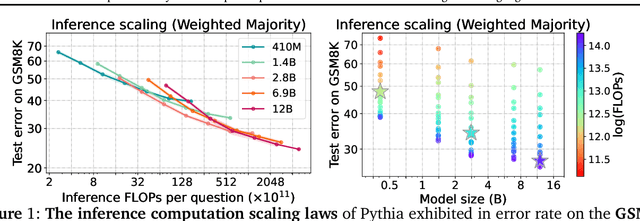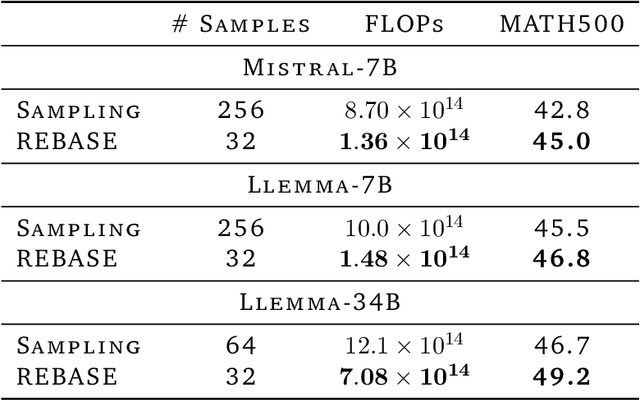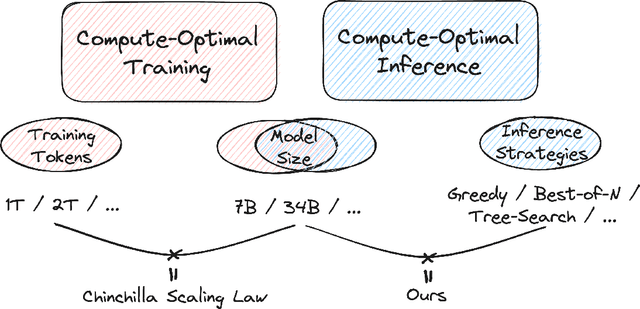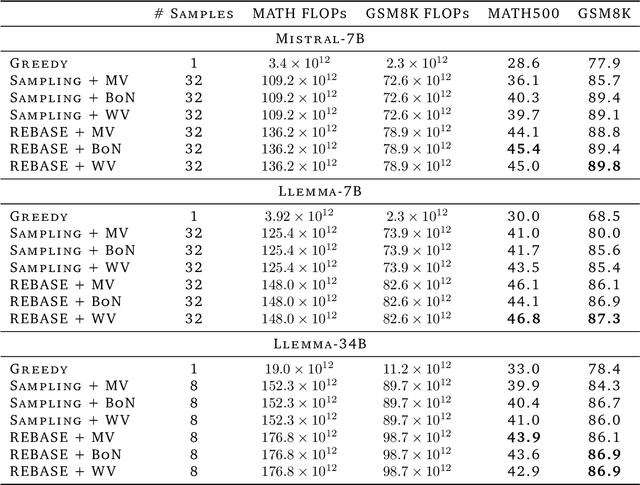Shanda Li
Scaling Latent Reasoning via Looped Language Models
Oct 29, 2025Abstract:Modern LLMs are trained to "think" primarily via explicit text generation, such as chain-of-thought (CoT), which defers reasoning to post-training and under-leverages pre-training data. We present and open-source Ouro, named after the recursive Ouroboros, a family of pre-trained Looped Language Models (LoopLM) that instead build reasoning into the pre-training phase through (i) iterative computation in latent space, (ii) an entropy-regularized objective for learned depth allocation, and (iii) scaling to 7.7T tokens. Ouro 1.4B and 2.6B models enjoy superior performance that match the results of up to 12B SOTA LLMs across a wide range of benchmarks. Through controlled experiments, we show this advantage stems not from increased knowledge capacity, but from superior knowledge manipulation capabilities. We also show that LoopLM yields reasoning traces more aligned with final outputs than explicit CoT. We hope our results show the potential of LoopLM as a novel scaling direction in the reasoning era. Our model could be found in: http://ouro-llm.github.io.
Towards Community-Driven Agents for Machine Learning Engineering
Jun 25, 2025Abstract:Large language model-based machine learning (ML) agents have shown great promise in automating ML research. However, existing agents typically operate in isolation on a given research problem, without engaging with the broader research community, where human researchers often gain insights and contribute by sharing knowledge. To bridge this gap, we introduce MLE-Live, a live evaluation framework designed to assess an agent's ability to communicate with and leverage collective knowledge from a simulated Kaggle research community. Building on this framework, we propose CoMind, a novel agent that excels at exchanging insights and developing novel solutions within a community context. CoMind achieves state-of-the-art performance on MLE-Live and outperforms 79.2% human competitors on average across four ongoing Kaggle competitions. Our code is released at https://github.com/comind-ml/CoMind.
Maximal Update Parametrization and Zero-Shot Hyperparameter Transfer for Fourier Neural Operators
Jun 24, 2025Abstract:Fourier Neural Operators (FNOs) offer a principled approach for solving complex partial differential equations (PDEs). However, scaling them to handle more complex PDEs requires increasing the number of Fourier modes, which significantly expands the number of model parameters and makes hyperparameter tuning computationally impractical. To address this, we introduce $\mu$Transfer-FNO, a zero-shot hyperparameter transfer technique that enables optimal configurations, tuned on smaller FNOs, to be directly applied to billion-parameter FNOs without additional tuning. Building on the Maximal Update Parametrization ($\mu$P) framework, we mathematically derive a parametrization scheme that facilitates the transfer of optimal hyperparameters across models with different numbers of Fourier modes in FNOs, which is validated through extensive experiments on various PDEs. Our empirical study shows that Transfer-FNO reduces computational cost for tuning hyperparameters on large FNOs while maintaining or improving accuracy.
Sample Complexity and Representation Ability of Test-time Scaling Paradigms
Jun 05, 2025Abstract:Test-time scaling paradigms have significantly advanced the capabilities of large language models (LLMs) on complex tasks. Despite their empirical success, theoretical understanding of the sample efficiency of various test-time strategies -- such as self-consistency, best-of-$n$, and self-correction -- remains limited. In this work, we first establish a separation result between two repeated sampling strategies: self-consistency requires $\Theta(1/\Delta^2)$ samples to produce the correct answer, while best-of-$n$ only needs $\Theta(1/\Delta)$, where $\Delta < 1$ denotes the probability gap between the correct and second most likely answers. Next, we present an expressiveness result for the self-correction approach with verifier feedback: it enables Transformers to simulate online learning over a pool of experts at test time. Therefore, a single Transformer architecture can provably solve multiple tasks without prior knowledge of the specific task associated with a user query, extending the representation theory of Transformers from single-task to multi-task settings. Finally, we empirically validate our theoretical results, demonstrating the practical effectiveness of self-correction methods.
A Comprehensive Evaluation of Contemporary ML-Based Solvers for Combinatorial Optimization
May 22, 2025Abstract:Machine learning (ML) has demonstrated considerable potential in supporting model design and optimization for combinatorial optimization (CO) problems. However, much of the progress to date has been evaluated on small-scale, synthetic datasets, raising concerns about the practical effectiveness of ML-based solvers in real-world, large-scale CO scenarios. Additionally, many existing CO benchmarks lack sufficient training data, limiting their utility for evaluating data-driven approaches. To address these limitations, we introduce FrontierCO, a comprehensive benchmark that covers eight canonical CO problem types and evaluates 16 representative ML-based solvers--including graph neural networks and large language model (LLM) agents. FrontierCO features challenging instances drawn from industrial applications and frontier CO research, offering both realistic problem difficulty and abundant training data. Our empirical results provide critical insights into the strengths and limitations of current ML methods, helping to guide more robust and practically relevant advances at the intersection of machine learning and combinatorial optimization. Our data is available at https://huggingface.co/datasets/CO-Bench/FrontierCO.
CodePDE: An Inference Framework for LLM-driven PDE Solver Generation
May 13, 2025Abstract:Partial differential equations (PDEs) are fundamental to modeling physical systems, yet solving them remains a complex challenge. Traditional numerical solvers rely on expert knowledge to implement and are computationally expensive, while neural-network-based solvers require large training datasets and often lack interpretability. In this work, we frame PDE solving as a code generation task and introduce CodePDE, the first inference framework for generating PDE solvers using large language models (LLMs). Leveraging advanced inference-time algorithms and scaling strategies, CodePDE unlocks critical capacities of LLM for PDE solving: reasoning, debugging, selfrefinement, and test-time scaling -- all without task-specific tuning. CodePDE achieves superhuman performance across a range of representative PDE problems. We also present a systematic empirical analysis of LLM generated solvers, analyzing their accuracy, efficiency, and numerical scheme choices. Our findings highlight the promise and the current limitations of LLMs in PDE solving, offering a new perspective on solver design and opportunities for future model development. Our code is available at https://github.com/LithiumDA/CodePDE.
CO-Bench: Benchmarking Language Model Agents in Algorithm Search for Combinatorial Optimization
Apr 06, 2025Abstract:Although LLM-based agents have attracted significant attention in domains such as software engineering and machine learning research, their role in advancing combinatorial optimization (CO) remains relatively underexplored. This gap underscores the need for a deeper understanding of their potential in tackling structured, constraint-intensive problems-a pursuit currently limited by the absence of comprehensive benchmarks for systematic investigation. To address this, we introduce CO-Bench, a benchmark suite featuring 36 real-world CO problems drawn from a broad range of domains and complexity levels. CO-Bench includes structured problem formulations and curated data to support rigorous investigation of LLM agents. We evaluate multiple agent frameworks against established human-designed algorithms, revealing key strengths and limitations of current approaches and identifying promising directions for future research. CO-Bench is publicly available at https://github.com/sunnweiwei/CO-Bench.
TFG-Flow: Training-free Guidance in Multimodal Generative Flow
Jan 24, 2025



Abstract:Given an unconditional generative model and a predictor for a target property (e.g., a classifier), the goal of training-free guidance is to generate samples with desirable target properties without additional training. As a highly efficient technique for steering generative models toward flexible outcomes, training-free guidance has gained increasing attention in diffusion models. However, existing methods only handle data in continuous spaces, while many scientific applications involve both continuous and discrete data (referred to as multimodality). Another emerging trend is the growing use of the simple and general flow matching framework in building generative foundation models, where guided generation remains under-explored. To address this, we introduce TFG-Flow, a novel training-free guidance method for multimodal generative flow. TFG-Flow addresses the curse-of-dimensionality while maintaining the property of unbiased sampling in guiding discrete variables. We validate TFG-Flow on four molecular design tasks and show that TFG-Flow has great potential in drug design by generating molecules with desired properties.
An Empirical Analysis of Compute-Optimal Inference for Problem-Solving with Language Models
Aug 01, 2024



Abstract:The optimal training configurations of large language models (LLMs) with respect to model sizes and compute budgets have been extensively studied. But how to optimally configure LLMs during inference has not been explored in sufficient depth. We study compute-optimal inference: designing models and inference strategies that optimally trade off additional inference-time compute for improved performance. As a first step towards understanding and designing compute-optimal inference methods, we assessed the effectiveness and computational efficiency of multiple inference strategies such as Greedy Search, Majority Voting, Best-of-N, Weighted Voting, and their variants on two different Tree Search algorithms, involving different model sizes and computational budgets. We found that a smaller language model with a novel tree search algorithm typically achieves a Pareto-optimal trade-off. These results highlight the potential benefits of deploying smaller models equipped with more sophisticated decoding algorithms in budget-constrained scenarios, e.g., on end-devices, to enhance problem-solving accuracy. For instance, we show that the Llemma-7B model can achieve competitive accuracy to a Llemma-34B model on MATH500 while using $2\times$ less FLOPs. Our findings could potentially apply to any generation task with a well-defined measure of success.
Functional Interpolation for Relative Positions Improves Long Context Transformers
Oct 06, 2023Abstract:Preventing the performance decay of Transformers on inputs longer than those used for training has been an important challenge in extending the context length of these models. Though the Transformer architecture has fundamentally no limits on the input sequence lengths it can process, the choice of position encoding used during training can limit the performance of these models on longer inputs. We propose a novel functional relative position encoding with progressive interpolation, FIRE, to improve Transformer generalization to longer contexts. We theoretically prove that this can represent some of the popular relative position encodings, such as T5's RPE, Alibi, and Kerple. We next empirically show that FIRE models have better generalization to longer contexts on both zero-shot language modeling and long text benchmarks.
 Add to Chrome
Add to Chrome Add to Firefox
Add to Firefox Add to Edge
Add to Edge